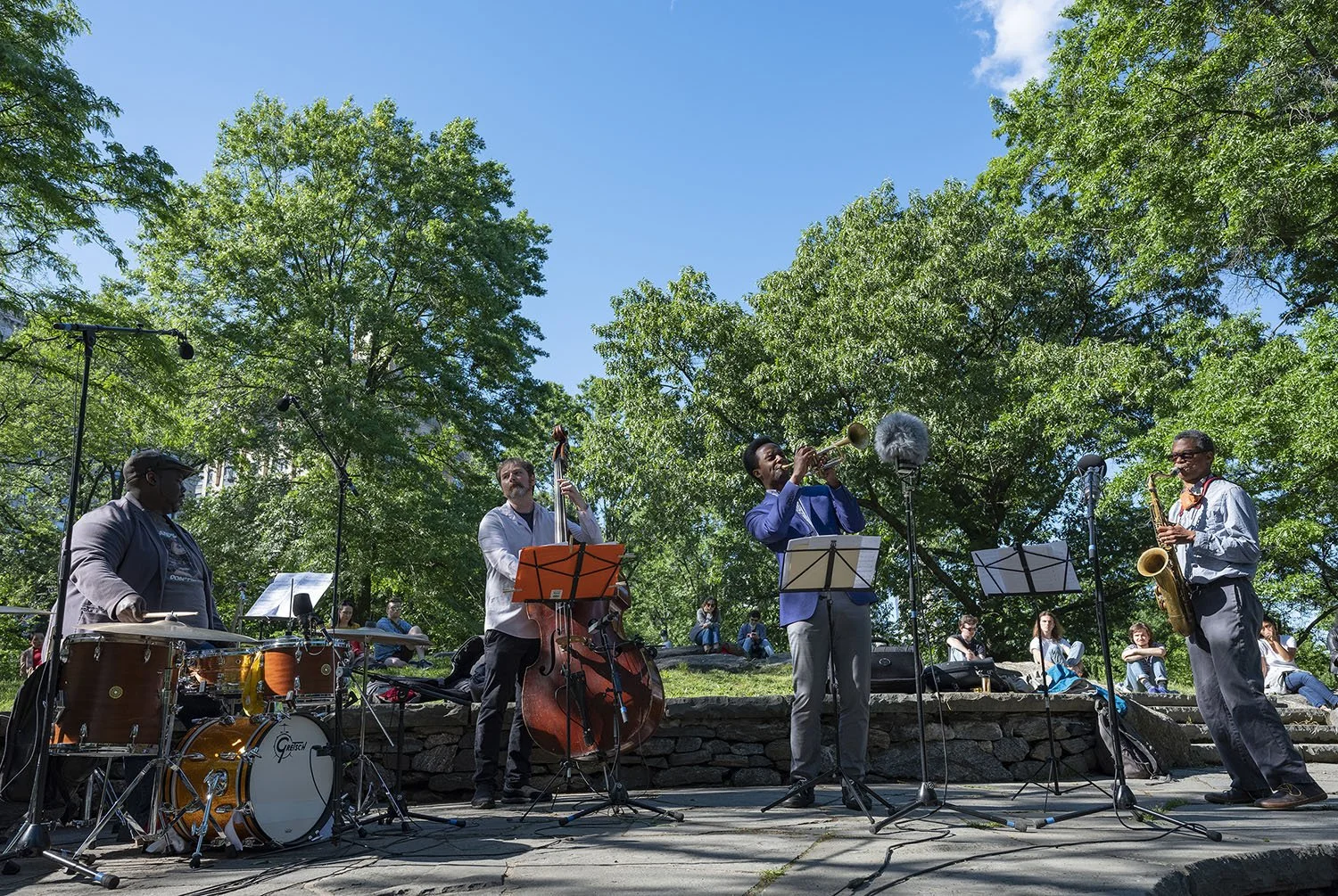“Live from Summit Rock” Central Park Concert Series Captured on Disc
How Jimmy Katz created a legendary COVID-era performance series in New York City
PUBLISHED JUNE 16, 2022 – BY THOMAS CONRAD
Jimmy Katz leads many lives. He is the preeminent currently active jazz photographer, and has shot more than 200 magazine covers and over 600 recording sessions. About 12 years ago he became an audio engineer, specializing in live recordings. His albums like Ralph Lalama’s Bopjuice: Live at Smalls are breakthroughs. They capture the blood-and-guts of live jazz with sonic resolution worthy of the best studios.
In 2018, Katz began another new life. He launched Giant Step Arts. It was a new record label—an outlet for his latest live recordings—but it was also much more: a 501(c)(3) nonprofit organization that presented live performances, recorded them in state-of-the-art sound, and provided CDs and 24/96 downloads for the bandleaders to sell themselves. Katz’s ambitions for the label were lofty; he said at the time, “I work with musicians who are ready to make large, bold artistic statements.” The first five GSA releases in 2019 and 2020, by Jason Palmer (two), Johnathan Blake, Eric Alexander, and Michael Thomas, were exactly that.
But in early 2020, the pandemic stopped GSA in its tracks. What do you do if you operate a label dedicated to live recordings and all the venues are suddenly shuttered? If you’re Jimmy Katz, you improvise. He says, “One day during the lockdown my wife Dena and I were strolling in Central Park and we came upon Wayne Escoffery, just playing with some guys. It put an idea in my head.”
The idea became 33 concerts in Central Park, starting in the early fall of 2020. Many of the best players in New York participated: Chris Potter, Melissa Aldana, Immanuel Wilkins, Nasheet Waits, Antonio Sánchez, James Brandon Lewis. Katz gave the series a name: “Walk with the Wind.” It comes from the title of a memoir by John Lewis, the great civil rights leader, who had died in July 2020.
The first 13 concerts took place at the Mall, in front of the Shakespeare statue. “But then,” Katz recounts, “I found a quieter, more isolated place: Summit Rock, the highest natural point in the park.” It also denotes an area that used to be called Seneca Village—which, from 1825 until 1857, had been the largest community of free African American property owners in pre-Civil War New York. The history of the location resonated with the theme of John Lewis’ lifelong fight for social justice.
Katz put on 20 concerts at Summit Rock in the spring and early summer of 2021. “I was amazed by how much live music meant to the people who came out,” he says. “Also to the musicians. The concerts were like block parties, community hangs. Somewhere between 50 and 300 people came. Many were hardcore jazz fans, but there were also folks just out walking their dogs who heard this incredible music and stopped to listen. When you hear someone like Mark Turner, you might not know much about jazz but you know you are hearing human expression at the highest level.”
The concerts were only possible because the pandemic had forced the NYC Parks Department to reduce its operations. When the authorities resumed enforcing regulations in July of 2021, the music stopped. The “Walk with the Wind” concerts are fading into legend now, but two special afternoons have been preserved. Katz recorded performances by the Jason Palmer Quartet and the Abraham Burton/Eric McPherson Trio; two volumes titled Live from Summit Rock in Seneca Village were released June 19 (“Juneteenth”) on Giant Step Arts. They are both vivid slices of life.
Palmer’s band has the leader on trumpet, Mark Turner on tenor saxophone, Edward Perez on bass, and Johnathan Blake on drums. Palmer is a high-flying improviser who takes wild risks but almost always sticks his landings. Turner continuously exemplifies what Katz called “human expression at the highest level.” Blake’s drums are orchestral. The trio co-led by tenor saxophonist Burton and drummer McPherson, and also featuring bassist Dezron Douglas, is mostly about the exhilaration of unleashed power. “Seneca Blues” sounds like it might roll on forever. But Burton sometimes turns inward. He lingers, lovingly, for 12 minutes, on “If You Could See Me Now.”
“Recording outside is extremely challenging,” Katz says. “We had no electricity. My recording gear had to be battery-powered. I had to position the mics to minimize extraneous noises.” But the Seneca Village recordings are Katz’s greatest engineering achievement. He renders every instrument with detailed clarity, and he leaves in enough “extraneous noises” to impart the communal vibe of the block party. At the opening of Palmer’s album, an airplane flies over, in a perfect left-to-right pan.
Katz, of course, has moved on, recording several concerts in a new series for Giant Step Arts called “Meditations on Freedom.” And he has moved back indoors. In June he recorded Palmer and Turner again in a very workable space with no airplanes: the Village Vanguard.
